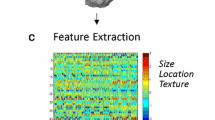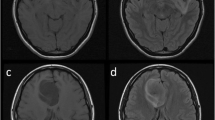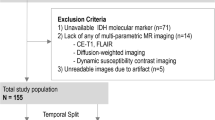Abstract
Objectives
To develop and validate a radiomics nomogram to preoperative prediction of isocitrate dehydrogenase (IDH) genotype for astrocytomas, which might contribute to the pretreatment decision-making and prognosis evaluating.
Methods
One hundred five astrocytomas (Grades II–IV) with contrast-enhanced T1-weighted imaging (CE-T1WI), T2 fluid-attenuated inversion recovery (T2FLAIR), and apparent diffusion coefficient (ADC) map were enrolled in this study (training cohort: n = 74; validation cohort: n = 31). IDH1/2 genotypes were determined using Sanger sequencing. A total of 3882 radiomics features were extracted. Support vector machine algorithm was used to build the radiomics signature on the training cohort. Incorporating radiomics signature and clinico-radiological risk factors, the radiomics nomogram was developed. Receiver operating characteristic (ROC) curve and area under the curve (AUC) were used to assess these models. Kaplan–Meier survival analysis and log rank test were performed to assess the prognostic value of the radiomics nomogram.
Results
The radiomics signature was built by six selected radiomics features and yielded AUC values of 0.901 and 0.888 in the training and validation cohorts. The radiomics nomogram based on the radiomics signature and age performed better than the clinico-radiological model (training cohort, AUC = 0.913 and 0.817; validation cohort, AUC = 0.900 and 0.804). Additionally, the survival analysis showed that prognostic values of the radiomics nomogram and IDH genotype were similar (log rank test, p < 0.001; C-index = 0.762 and 0.687; z-score test, p = 0.062).
Conclusions
The radiomics nomogram might be a useful supporting tool for the preoperative prediction of IDH genotype for astrocytoma, which could aid pretreatment decision-making.
Key Points
• The radiomics signature based on multiparametric and multiregional MRI images could predict IDH genotype of Grades II–IV astrocytomas.
• The radiomics nomogram performed better than the clinico-radiological model, and it might be an easy-to-use supporting tool for IDH genotype prediction.
• The prognostic value of the radiomics nomogram was similar with that of the IDH genotype, which might contribute to prognosis evaluating.






Similar content being viewed by others
Abbreviations
- ADC:
-
Apparent diffusion coefficient
- AUC:
-
Area under the curve
- CE-T1WI:
-
Contrast-enhanced T1-weighted images
- IDH:
-
Isocitrate dehydrogenase
- IDH-M:
-
Isocitrate dehydrogenase mutant type
- IDH-W:
-
Isocitrate dehydrogenase wild type
- LASSO:
-
Least absolute shrinkage and selection operator
- LOOCV:
-
Leave-one-out cross-validation
- OS:
-
Overall survival
- RFE:
-
Recursive feature elimination
- ROC:
-
Receiver operating characteristic
- ROI:
-
Regions of interest
- SVM:
-
Linear support vector machine
- T2FLAIR:
-
T2 fluid-attenuated inversion recovery images
References
Ichimura K, Narita Y, Hawkins CE (2015) Diffusely infiltrating astrocytomas: pathology, molecular mechanisms and markers. Acta Neuropathol 129(6):789–808
Louis DN, Perry A, Reifenberger G et al (2016) The 2016 world health organization classification of tumours of the central nervous system: a summary. Acta Neuropathol 131(6):803–820
Rogers TW, Tsui A, Gonzales M (2018) Re-classification of gliomas by the 2016 revision of the who classification of CNS tumours. Pathology 50(Sup1):S123
Brat DJ, Verhaak RG, Aldape KD et al (2015) Comprehensive, integrative genomic analysis of diffuse lower-grade gliomas. N Engl J Med 372(26):2481–2498
Beiko J, Suki D, Hess KR et al (2014) IDH1 mutant malignant astrocytomas are more amenable to surgical resection and have a survival benefit associated with maximal surgical resection. Neuro Oncol 16(1):81–91
Kizilbash SH, Giannini C, Voss JS et al (2014) The impact of concurrent temozolomide with adjuvant radiation and IDH mutation status among patients with anaplastic astrocytoma. J Neurooncol 120(1):85–93
Tran AN, Lai A, Li S et al (2016) Increased sensitivity to radiochemotherapy in IDH1 mutant glioblastoma as demonstrated by serial quantitative MR volumetry. Neuro Oncol 16(3):414–420
Rohle D, Popovici-Muller J, Palaskas N et al (2013) An inhibitor of mutant IDH1 delays growth and promotes differentiation of glioma cells. Science 340(6132):626–630
Waitkus MS, Dilpas BH, Yan H (2018) Biological role and therapeutic potential of IDH mutation in cancer. Cancer Cell. https://doi.org/10.1061/j.ccell.2-18.04.011
Andronesi OC, Arrillaga-Romany IC, Ina Ly K et al (2018) Pharmacodynamics of mutant-IDH1 inhibitors in glioma patients probed by in vivo 3D MRS imaging of 2-hydroxyglutarate. Nat Commun 9:1474. https://doi.org/10.1038/s41467-018-03905-6
Sullivan DC, Obuchowski NA, Kessler LG et al (2015) Metrology standards for quantitative imaging biomarkers. Radiology 277(3):813–825
Liu Z, Zhang Y, Yan H et al (2012) Altered topological patterns of brain networks in mild cognitive impairment and Alzheimer's disease: a resting-state fMRI study. Psychiat Res-Neuroim 202(2):118–125
Qi S, Yu L, Li H et al (2014) Isocitrate dehydrogenase mutation is associated with tumour location and magnetic resonance imaging characteristics in astrocytic neoplasms. Oncol Lett 7(6):1895–1902
Metellus P, Coulibaly B, Colin C et al (2010) Absence of IDH mutation identifies a novel radiologic and molecular subtype of WHO grade II gliomas with dismal prognosis. Acta Neuropathol 120(6):719–729
Gillies RJ, Kinahan PE, Hricak H (2015) Radiomics: images are more than pictures, they are data. Radiology 278(2):563–577
Lambin P, Leijenaar RTH, Deist TM et al (2017) Radiomics: the bridge between medical imaging and personalized medicine. Nat Rev Clin Oncol 14:947–762
Yu J, Shi Z, Lian Y et al (2017) Noninvasive IDH1 mutation estimation based on a quantitative radiomics approach for grade II glioma. Eur Radiol 27(8):3509–3522
Li Z, Wang Y, Yu J, Guo Y, Cao W (2017) Deep learning based radiomics (DLR) and its usage in noninvasive IDH1 prediction for low grade glioma. Sci Rep 7(1):5467
Zhang X, Tian Q, Wang L et al (2018) Radiomics strategy for molecular subtype stratification of lower-grade glioma: detecting IDH and TP53 mutations based on multimodal MRI. J Magn Reson Imaging. https://doi.org/10.1002/jmri.25960
Zhang B, Chang K, Ramkissoon S et al (2017) Multimodel MRI features predict isocitrate dehydrogenase genotype in high-grade gliomas. Neuro Oncol 19(1):109–117
Hsieh KL, Chen CY, Lo CM (2017) Radiomic model for predicting mutations in the isocitrate dehydrogenase gene in glioblastomas. Oncotarget 8(28):45888–45897
Baldock AL, Yagle K, Born DE et al (2014) Invasion and proliferation kinetics in enhancing gliomas predict IDH1 mutation status. Neuro Oncol 16(6):779–786
Chen J, Tian J (2009) Real-time multi-modal rigid registration based on a novel symmetric-SIFT descriptor. Prog Nat Sci 19(5):643–651
Gebejes A, Huertas R (2013) Texture characterization based on grey-level co-occurrence matrix. International Conference on Information and Communication Technologies 1:375–378
Galloway MM (1975) Texture analysis using gray level run lengths. Computer Graphics and Image Processing 4:172–179
Chu A, Sehgal CM, Greenleaf JF (1990) Use of gray value distribution of run lengths for texture analysis. Pattern Recognit Lett 11:415–419
Dasarathy BV, Holder EB (1991) Image characterizations based on joint gray level—run length distributions. Pattern Recognit Lett 12:497–502
Thibault G, Fertil B, Navarro C et al (2013) Shape and texture indexes application to cell nuclei classification. Intern J Pattern Recognit Artif Intell 27:1357002
Thibault G, Fertil B, Navarro C et al (2009) Texture indexes and gray level size zone matrix: application to cell nuclei classification. Pattern Recognition Inf Process 140–145
Amadasun M, King R (1989) Textural features corresponding to textural properties. IEEE Trans Syst Man Cybern 19:1264–1274
Zhang B, Tian J, Dong D et al (2017) Radiomics features of multiparametric MRI as novel prognostic factors in advanced nasopharyngeal carcinoma. Clin Cancer Res 23(15):4259–4269
Chalkidou A, O’Doherty MJ, Marsden PK et al (2015) False discovery rates in PET and CT studies with texture features: a systematic review. PLoS One 10(5):e0124165
Rathore S, Akbari H, Doshi J et al (2018) Radiomic signature of infiltration in peritumoural edema predicts subsequent recurrence in glioblastoma: implications for personalized radiotherapy planning. J Med Imaging (Bellingham) 5(2):021219. https://doi.org/10.1117/1.JMI.5.2.021219
Prasanna P, Patel J, Partov S, Anant Madabhushi A, Tiwari R (2017) Radiomic features from the peritumoural brain parenchyma on treatment-naïve multi-parametric MR imaging predict long versus short-term survival in glioblastoma multiforme: preliminary findings. Eur Radiol 27:4188–4197
Parsons DW, Jones S, Zhang X et al (2008) An integrated genomic analysis of human glioblastoma multiforme. Science 321(5897):1807–1812
Dang L, Yen K, Attar EC (2016) IDH mutations in cancer and progress toward development of targeted therapeutics. Ann Oncol 27(4):599–608
Colen R, Ashour O, Zinn PO (2013) Imaging genomic IDH-1 biomarker signature. Neuro Oncol 15(Suppl 3):iii191–iii205
Santelli L, Ramondo G, Della Puppa A et al (2010) Diffusion-weighted imaging does not predict histological grading in meningiomas. Acta Neurochir (Wien) 152(8):1315–1319
Lam WW, Poon WS, Metreweli C (2002) Diffusion MR imaging in glioma: does it have any role in the pre-operation determination of grading of glioma. Clin Radiol 57(3):219–225
Xing Z, Yang X, She D, Lin Y, Zhang Y, Cao D (2017) Noninvasive assessment of IDH mutational status in World Health Organization Grade II and III Astrocytomas using DWI and DSC-PWI combined with conventional MR imaging. AJNR Am J Neuroradiol 38(6):1138–1144
Turcan S, Rohle D, Goenka A et al (2012) IDH mutation is sufficient to establish the glioma hypermethylator phenotype. Nature 483(7390):479–483
Reuss DE, Mamatjan Y, Schrimpf D et al (2015) IDH mutant diffuse and anaplastic astrocytomas have similar age at presentation and little difference in survival: a grading problem for WHO. Acta Neuropathol 129(6):867–873
Funding
This study has received funding by the National Natural Science Foundation (81471652 and 81771824 to Hui Zhang; 81227901, 81527805, 61231004, and 81671851 to Jie Tian; 81701681 to Yan Tan; 81771924, 81501616 to Di Dong; 11705112 to Guo-qiang Yang); National Key R&D Program of China (2017YFA0205200 and 2017YFC1309100 to Jie Tian, 2017YFC1308700 to Di Dong); the Precision Medicine Key Innovation Team Project (YT1601 to Hui Zhang); the Social Development Projects of Key R&D Program in Shanxi Province (201703D321016 to Hui Zhang); and the Natural Science Foundation of Shanxi Province (201601D021162 to Yan Tan).
Author information
Authors and Affiliations
Corresponding authors
Ethics declarations
Guarantor
The scientific guarantor of this publication is Hui Zhang.
Conflict of interest
The authors of this manuscript declare no relationships with any companies, whose products or services may be related to the subject matter of the article.
Statistics and biometry
One of the authors has significant statistical expertise.
Informed consent
Written informed consent was not required for this study because this is a retrospective study and patient data are anonymized.
Ethical approval
Institutional Review Board approval was obtained.
Methodology
• retrospective
• diagnostic or prognostic study
• performed at one institution
Additional information
Publisher’s note
Springer Nature remains neutral with regard to jurisdictional claims in published maps and institutional affiliations.
Electronic supplementary material
ESM 1
(DOCX 1175 kb)
Rights and permissions
About this article
Cite this article
Tan, Y., Zhang, St., Wei, Jw. et al. A radiomics nomogram may improve the prediction of IDH genotype for astrocytoma before surgery. Eur Radiol 29, 3325–3337 (2019). https://doi.org/10.1007/s00330-019-06056-4
Received:
Revised:
Accepted:
Published:
Issue Date:
DOI: https://doi.org/10.1007/s00330-019-06056-4




